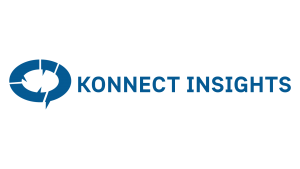Many businesses already have a social listening strategy in place. For beginners, social listening is the practice of monitoring conversations and interactions happening on various online channels. The aim is to gain valuable, actionable insights about customers. Social listening allows businesses to better understand customers’ needs, wants, pain points, and expectations.
With the help of social listening platforms and tools, companies can catch online conversations about their brand. This data can be analyzed and interpreted to develop an effective decision-making strategy.
For example, a business can use social listening to identify emerging trends. This can also help evaluate customer feedback on these trends and adapt strategies accordingly.
“A brand is no longer what we tell the consumer it is. It is what consumers tell each other it is.” Scott D. Cook, Co-Founder, Intuit
At its core, effective decision-making is all about having the right information at the right time. With social listening, businesses can stay ahead of their competition. They can make informed decisions that will ensure their success.
This whitepaper offers an in-depth study of social listening and how businesses can use it to produce insights. These insights can be used to make decisions that will have a positive impact. It covers topics such as the importance of social listening, methods and tools required, key benefits, challenges, and other strategies.
By the end of this whitepaper, businesses will have an extensive idea of social listening. They can use it to gain actionable insights and make informed decisions.
Understanding Social Listening: A Powerful Tool for Data-Driven Decision-Making
First and foremost, it is important to understand what social listening is and how to use it effectively. For this, we need to take a look at several different components. These include:
The Evolution of Social Listening: From Monitoring to Strategic Decision-Making
In recent years, social listening has evolved significantly. From being a mere monitoring tool, it has become a powerful instrument for making strategic choices. Social media is rising rapidly with the ever-increasing amount of digital content. Businesses have realized the importance of utilizing the vast amounts of useful insight hidden within these vast digital landscapes.
Social listening has emerged as a valuable practice that goes beyond basic monitoring. It allows decision-makers to understand their target audience, competitors, industry trends, and overall market sentiment.
In a survey, about 68% of public relations professionals said that social listening is important to them. Business Wire
One of the driving forces behind this evolution is the accessibility of social media data. Platforms like Twitter, Facebook, Instagram, and LinkedIn generate enormous amounts of user-generated content daily. This user-generated content is a digital goldmine of insights, opinions, and conversations.
This data can shape the decision-making process. Advanced social listening tools and technologies now enable businesses to efficiently collect, analyze, and interpret this data. It unlocks actionable insights that were once hidden from view.
Watch out: 6 Social Listening Trends in 2023 to stay ahead of the game
The Importance of Social Listening in the Digital Age
- There are around 930 million LinkedIn users in more than 200 countries and territories worldwide.
- Facebook has 2.98 billion monthly active users. This makes it the biggest social media platform.
- There are over 2.35 billion monthly active Instagram users. It is the most popular platform among Generation Z.
- There are over 368 million monthly active Twitter users worldwide.
In today’s digital age, social media platforms and online communities have become integral parts of our daily lives. Understanding social listening has become more important than before.
The importance of social listening lies in its ability to provide real-time, unfiltered feedback and opinions from a vast pool of online users. It also offers an opportunity for early involvement with customers. Lastly, social listening serves as a powerful tool for market research and competitor analysis.
In a nutshell, in a world where customer feedback and opinions are readily available, taking advantage of social listening is no longer a luxury. It has become a necessity for businesses to succeed in the digital age.
Key Benefits of Including Social Listening in Business Strategies
By actively keeping track of conversations and trends across social media, businesses can unlock actionable insights that shape their strategies and drive success. Here are the key benefits of including social listening in our business strategies:
- Understand our target audience
Social listening provides a direct window into the thoughts, opinions, and preferences of our target audience. This knowledge allows us to tailor our products, services, and marketing campaigns to meet their expectations effectively.
69% of online shoppers who use Meta platforms weekly made purchases after seeing personalized content on Facebook or Instagram. - Enhance brand reputation and customer satisfaction
Social listening lets us track mentions and sentiments around our brand in real-time. This helps us engage with customers, which shows that we value their opinions and are committed to providing exceptional experiences. - Identify emerging trends and market opportunities
Through social listening, we can stay ahead of the curve by identifying emerging trends and market opportunities. We can spot gaps in the market and adapt our strategies to capitalize on new trends, ensuring our business remains competitive and relevant. - Optimize marketing campaigns
Social listening provides actionable insights into how our marketing campaigns resonate with our audience. This data-driven approach enables us to make informed decisions to optimize our marketing efforts and maximize ROI. - Conduct effective competitor analysis
Social listening allows us to monitor conversations about our competitors and gain insights into their strategies, products, and customer feedback. This information helps us benchmark our performance, identify areas for improvement, and identify competitive advantages that differentiate our business. - Identify and engage with influencers
Social listening enables us to identify influential people in our industry or niche. Building relationships with these influencers can amplify our reach, enhance brand credibility, and drive organic growth.
60% of pros use social listening to find influencers. - Proactively manage crises and reputation management
Social listening serves as an early warning system for potential crises or reputation management issues. This proactive approach allows us to swiftly respond, minimize damage, and protect our brand or reputation.
Burger King UK is under fire for tweeting, ‘Women belong in the kitchen’ on International Women’s Day. - Improve product development and innovation: Lastly, social listening provides insights into customer needs, preferences, and pain points. This customer-centric approach to product development increases the likelihood of success in the market.
Read more: 20 Benefits of Using Social Listening Tools for Your Business
Methods and Tools for Effective Social Listening
In the realm of social listening, having the right methods and tools in place is crucial to extracting meaningful insights from the vast sea of digital conversations. Here, we explore the key methods and tools that can enhance the success of our social listening efforts:
- Define objectives
We need to start by clearly defining our social listening objectives. We need to determine what insights we want to gather, whether it is customer sentiment, brand reputation, or market trends.
- Select the right keywords and topics
Once we have a clear social listening goal, we must choose relevant keywords and topics that align with our objectives. These could include brand mentions, product names, industry-specific terms, and related hashtags.
- Monitor multiple channels
Effective social listening involves monitoring multiple social media channels, online forums, blogs, and news sites. Each platform provides a unique perspective and set of conversations.
- Utilize sentiment analysis
Sentiment analysis is a valuable technique that categorizes social media posts and mentions into positive, negative, or neutral sentiments. This allows us to gauge public sentiment toward our brand, products, or industry.
- Implement social listening tools
Social listening tools are essential for efficiently collecting and analyzing data. These tools can provide real-time monitoring, sentiment analysis, trend identification, and data visualization.
- Track influencers and brand advocates
Identify influential people and brand advocates within our industry or niche. Track their comments, interactions, and activities to understand their preferences and interests.
- Analyze and interpret data
Collecting data is only the first step; the true value lies in analyzing and interpreting the insights. We must look for patterns, trends, and correlations within the data to derive actionable insights.
- Incorporate automation and AI
Embrace automation and artificial intelligence (AI) technologies to streamline social listening processes. AI-powered tools can categorize and filter data, identify emerging trends, and provide sentiment analysis at scale.
- Continuously refine our approach
Social listening is an iterative process. We need to regularly assess and refine our methods and tools to adapt to changing trends and audience behaviors. We need to stay up-to-date with advancements in social listening technology and explore new features and capabilities that can enhance our insights.
Konnect Insight’s social listening tool is a comprehensive and robust solution for businesses aiming to extract actionable insights from the digital landscape. With its user-friendly interface and advanced features, Konnect Insight empowers businesses to monitor, analyze, and leverage social media conversations effectively.
From data aggregation to sentiment analysis, influencer tracking, and competitive analysis, Konnect Insight offers an extensive suite of features that facilitate effective social listening. By leveraging this tool, companies can stay connected with their audience, adapt to changing trends, and make data-informed decisions that drive success in the digital age.
Read about: 10 Important Factors For Selecting the Best Social Listening Tool For Your Business
Harnessing Actionable Insights from Social Listening Data
Once you have collected data through social listening, the next step is to harness the data to get insights for informed decision-making. This requires a structured approach and alignment with business objectives. Here is how to get started:
- We need to identify and prioritize the key goals of our social listening efforts. This will help us stay focused and ensure our efforts are directed toward the right initiatives.
- Social listening data can be overwhelming. To effectively harness insights, we must segment and prioritize the data based on relevance and impact. We need to identify key themes, sentiment patterns, and influencers most relevant to our objectives.
- Social listening data offers both qualitative and quantitative dimensions. Quantitative analysis provides statistical metrics. On the other hand, qualitative analysis helps uncover underlying motivations and emotions. Combining both approaches allows for a more complete sense of the insights. It also supports well-rounded decision-making.
- The true value of social listening lies in identifying insights that can drive actionable outcomes. We need to identify patterns, trends, and anomalies within the data that can inform strategic decisions.
- To gain a holistic view of our business, we need to integrate social listening data with other relevant data sources. These include sales figures, customer surveys, or market research. This leads to more accurate and impactful decision-making.
- Next, we need to foster cross-functional collaboration. This can be done by sharing the findings and insights across teams, such as marketing, product development, and sales. This joint effort ensures that insights are leveraged throughout the company.
- Lastly, we need to remember that social listening is an ongoing process. Regularly monitor conversations and trends to stay updated on evolving customer sentiments and market dynamics.
Learn more: How Can Social Listening Help Grow Your Business?
Case Studies: Successful Applications of Social Listening in Decision-Making
Here are a few case studies that demonstrate how companies have used social listening for effective decision-making:
1. DCB Bank’s Top Priority: Innovating and Enhancing Customer Satisfaction
During the pandemic, DCB Bank was onboarding new customers. They realized the shift toward digital banking channels. They needed to be more proactive in understanding customer needs to offer exceptional customer service. For this, they needed to track customer sentiments and preferences.
DCB Bank utilized social listening insights for customer segmentation and understanding consumer sentiment. They then targeted customers with fine-tuned and personalized messages. They were able to analyze customers’ feedback and support some previously unattended concerns. This social listening-driven decision-making led to improved customer satisfaction, increased customer loyalty, and a better ROI.
2. The Bike Taxi Brand Riding On Insights
A Bengaluru-based bike taxi aggregator and logistics service provider faced issues in its initial days. They were unable to keep track of customer reviews from multiple sources and understand their customers’ requirements.
They needed an effective solution to listen to their customers’ voices. They needed a way to extract actionable insights from their customers’ opinions. These opinions were scattered across social media. They wanted to analyze sentiment and determine their position as a brand in the market.
They leveraged social listening to gauge the audience’s opinions, their brand identity in the market, and their promotional or marketing campaign performance. This helped them design personalized experiences. They tapped into new opportunities to increase customer satisfaction.
With the help of social listening, they were able to enhance the quality of interactions and engagement with their customers on social media. The brand grew and was able to make more informed decisions while staying ahead of the competition.
Social listening is a powerful tool that helps brands like DCB Bank and the bike taxi aggregator better understand their customers, make intelligent decisions, and stay ahead of the competition.
Do you know: What Can Social Listening Do for Your Business?
Overcoming Challenges in Social Listening Implementation
While social listening opens up a plethora of opportunities, it can also be challenging for brands to implement. Some of the common challenges that brands face include:
- Data overload
It can be difficult to sift through and analyze the huge amount of data generated by social media platforms. To ensure successful and effective implementation, it is important to have an efficient system in place to store the data, analyze the data, and extract meaningful insights.
- Lack of resources
With limited resources, it can be difficult to implement a successful social listening strategy. To overcome this challenge, brands need to allocate their resources efficiently and focus on the most important tasks.
- Lack of understanding
Brands must understand the social media landscape and its dynamics to effectively implement a social listening strategy.
- Language and cultural nuances
Social listening involves monitoring conversations across different languages and cultures. Understanding language nuances, slang, and cultural references is essential for accurate analysis.
“Little Things: Big Differences”
The funny thing about the word ‘susu’ is that to Indian people, it’s ‘pee, and to Filipino people, it’s ‘tits. In Malaysia, ‘susu’ is ‘milk.
- Privacy and ethical issues
It is crucial to adhere to data protection regulations and ethical guidelines. This ensures data privacy and anonymization. Transparency in data collection and providing clear opt-out mechanisms for people are essential to maintaining trust and compliance.
- Actionability of insights
The ultimate goal of social listening is to derive actionable insights that drive business outcomes. However, translating insights into tangible actions can be a challenge. To ensure successful application, brands should have a well-defined plan in place to track and measure progress.
- Evolving technology and platforms
Social media platforms and digital trends evolve rapidly, posing a challenge to keeping up with the latest technologies and platforms relevant to social listening. It is important to stay updated with the latest tools and techniques, invest in training and development, and evaluate and adapt our social listening strategies.
Ethical Issues in Social Listening: Privacy, Consent, and Transparency
With social listening, ethical concerns are paramount. Businesses must navigate privacy, consent, and transparency to ensure ethical practices. Respecting people’s privacy is a must. It is to be ensured that data collected from social media platforms complies with relevant data protection regulations.
Obtaining informed consent from individuals for data collection and citing the purpose and scope of social listening initiatives is crucial. Transparency is essential when disclosing how data will be used. This ensures people understand their rights and have the option to opt-out.
Data protection and privacy laws, such as the European Union’s General Data Protection Regulation (GDPR), have increased the obligation of businesses to protect user data and ensure transparency. Businesses must be compliant with applicable data protection regulations when collecting and using social media data.
Best Practices for Leveraging Social Listening to Enhance Decision-Making
Companies using social listening as a decision-making tool should develop the following best practices for leveraging the insights gained:
It is important to ensure that the data collected provides a complete picture. Strategies should be designed to capture accurate insights.
They should also consider the context of the conversations they are monitoring. Such analysis can provide more accurate insights and ensure that decision-makers fully understand what is being discussed.
Lastly, businesses should consider creating a process for managing social listening initiatives. This will ensure that data is collected in an organized and systematic way. It will also help to ensure that insights are properly tracked, interpreted, and used for effective decision-making.
The Future of Social Listening: Emerging Trends and Technologies
The future of social listening holds exciting prospects as emerging trends and technologies continue to shape the landscape. AI, natural language processing, and advanced sentiment analysis will drive more accurate and real-time insights. Plus, integrating social listening with other data sources and the rise of social listening on emerging platforms will further enhance its potential.
Read about: How Can Social Listening Improve the Customer Experience?
Conclusion
Social listening is a vital tool for businesses looking to drive effective decision-making. By leveraging the actionable insights social listening provides, businesses can gain an in-depth idea of what customers are saying. They can then use these insights to develop informed strategies.
But businesses must ensure that they develop best practices for leveraging the insights provided by social listening. They also need to remain mindful of the latest trends and technologies that will shape their future. With the right approach, businesses can gain a competitive edge by leveraging the immense power of social listening.












